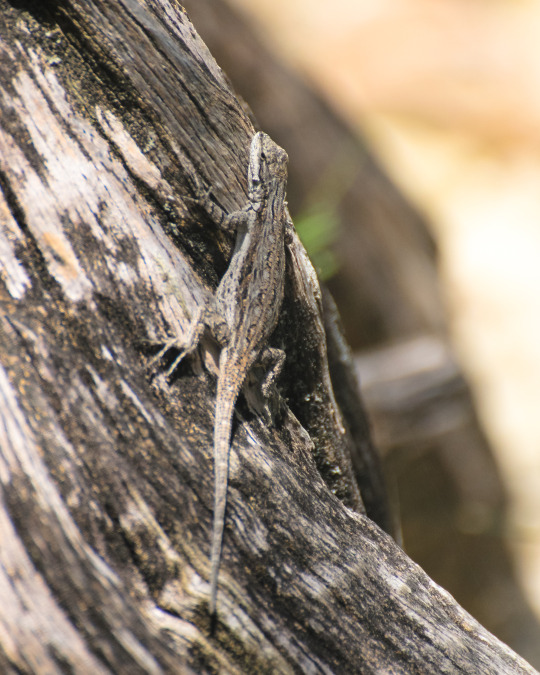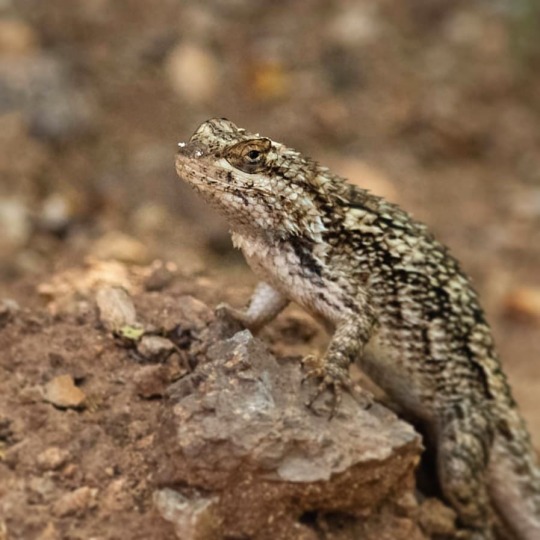#phrynosomatidae
Text

Minor Spiny Lizard (Sceloporus minor), male in full breeding colors, family Phrynosomatidae, Mexico
photograph by Sergio Terán-Natural
634 notes
·
View notes
Text
Uncharismatic Fact of the Day
Lyme disease is a serious issue in North America, but there is an unsung hero keeping this illness at bay: the Western Fence Lizard. A protein in their blood eliminates the bacteria that enters their bodies, and by extension clears the tick of all disease!

(Image: A western fence lizard (Sceloporus occidentalis) with a western black-legged tick (Ixodes pacificus)attatched behind the ear by Jerry Kirkhart via Wikimedia)
If you like what I do, consider leaving a tip or buying me a ko-fi!
#western fence lizard#Squamata#Phrynosomatidae#spiny lizards#lizards#squamates#reptiles#uncharismatic facts
742 notes
·
View notes
Photo

A greater short-horned lizard (Phrynosoma hernandesi) in the USA
by Noah K. Fields
#greater short horned lizard#lizards#reptiles#Phrynosoma hernandesi#Phrynosoma#Phrynosomatidae#squamata#reptilia#chordata#wildlife: usa
348 notes
·
View notes
Photo

Roundtail horned lizard (Phrynosoma modestum) in Texas, U.S.
Noah K. Fields
92 notes
·
View notes
Note
Please and thank you: tell me something about the desert, I’ve never met one, but would like to. Something big or small, just something lovely?
in the sonoran desert, when it rains during the monsoon, the desert petrichor mingles with the exudates of the creosote/chaparral and makes the most incredible scent. i smelled in when i visited in 2021 and it made me cry instantly
in phoenix, the introduced mediterranean gecko (Hemidactylus turcicus) has become incredibly common, and most of my childhood lizard memories are either of encounters with them, or with the tree lizard (Urosaurus ornatus). the geckos are really hidey and stay in the shadows and come out at night (you'll see them a lot around lamps eating the attracted insects), but the tree lizards are showy, and they love to dash around on cinderblock walls and soak up the sun, and do pushups at other tree lizards (males have a bright blue patch on their throat). until recently tree lizards were classified as part of a larger Iguanidae family, but were recently re-classified into the Phrynosomatidae family, which also includes the horned lizards* and spiny lizards, and you can see the relation between them in the shape of the top of their skull around the parietal eye. also i just found out that the oldest known member of this family, excavated in Mongolia, has been named Desertiguana, not to be confused with the desert iguana (Dipsosaurus dorsalis) which is found in the sonoran desert (& bordering deserts)
another incredible thing about the desert are tadpole shrimp (Triops) and spadefoot toads (genus Spea and Scaphiopus). during the monsoon these'll pop out of the dust and spend the next week or so fucking in the very temporary pools, and lay their eggs. the shrimp eggs will not hatch (and iirc need to be dried out before they will hatch) and will settle into swiftly drying mud. the spadefeet eggs will hatch and then mature incredibly swiftly, and the little toads will dig into the drying dirt and cover themselves with a membrane that will keep them moist until the next rains come.
also the sonoran desert at sunrise is just incredible, visually, and also aurally. all of the many many species of bird found in the desert sending out their symphonic cacophany into the morning. warbling cactus wren, whistling thrasher's and creaking grackles and the little cheep of the verdin (a little green-grey bird with a bright yellow head that's often found on the palo verde, which has green bark and bright yellow flowers). in some areas you might see gila woodpeckers nesting in holes in saguaros, and in the phoenix area a population of introduced peach-faced lovebirds has become established, and occupy seemingly a niche that nothing else was in, and sometimes you might see them amongst the cactopodes also.
*these fuckers eat ants and are so specialized in eating ants that they have a compound in their blood to neutralize formic acid and if they don't eat enough ants that need neutralized the compound builds up and poisons them. also some species can shoot blood out of their eyes. please don't make them do this
8 notes
·
View notes
Text

Minor Spiny Lizard (Sceloporus minor), male in full breeding colors, family Phrynosomatidae, Mexico. photograph by Sergio Terán-Natural
0 notes
Text
VERANO 2023 - LAGARTIJAS
13 de Junio 2023 - Silenciosa y vivaz, familiar y simpática, la lagartija es un reptil beneficioso que se alimenta de todo tipo de insectos e invertebrados.Hoy, en el blog, manualidades de lagartijas!
Lagartija es un término usado en varios países como nombre común para denominar a algunas o todas las especies de ciertos géneros de las familias Lacertidae, Gekkonidae y Phrynosomatidae. En España, específicamente en las provincias de Burgos, Cuenca y Palencia, “ligaterna” es un término equivalente a lagartija.
Las lagartijas acuden donde hay luz, por eso es común que las veas en las paredes…

View On WordPress
0 notes
Photo

Regal horned lizard (Phrynosoma solare)
Photo by Steven Wong
#fave#regal horned lizard#horned lizard#phrynosoma solare#phrynosoma#phrynosomatidae#pleurodonta#iguania#iguanomorpha#toxicofera#episquamata#unidentata#bifurcata#squamata#lepidosauria#sauria#diapsida#reptilia#sauropsida#tetrapoda#vertebrata#chordata
11 notes
·
View notes
Photo

Porridge, the side-blotched lizard. #phrynosomatidae
3 notes
·
View notes
Text

King lizard
0 notes
Photo


Ornate Tree Lizard
Urosaurus ornatus
Conan, Texas, United States, 2015
Garner State Park
#ornate tree lizard#urosaurus ornatus#tree lizard#brush lizard#urosaurus#phrynosomatidae#lizard#squamate#squamata#reptile#reptilia#Concan#Texas#United States#Garner State Park
17 notes
·
View notes
Text

Texas Horned Lizard (Phrynosoma cornutum), family Phrynosomatidae, found in the south central and south western United States and far northern Mexico
photograph by Sean Fitzgerald
454 notes
·
View notes
Photo



Admiring the Ornate Tree Lizard
The ornate tree lizard, or more commonly, simply the tree lizard (Urosaurus ornatus) is a species of lizard commonly found in the southwestern United States and northern Mexico. True to their name, they live primarily in riparian or dry forest areas, although they can also be found in scrubland, deserts, and urban areas. Tree lizards can be highly territorial, and an area can consist of a dominant male and several lesser males. Females have their own, individual territories that do not over lap. Despite their small size, barely two inches long, tree lizards can defend large territories, sometimes up to 250 square feet.
Tree lizards spend a majority of their time competing with other males, thermoregulating, or hunting. They are ambush predators, preferring to wait motionless for unsuspecting insects and arachnids to wander into their range. Their ability to remain still, combined with their dull mottled backs, also makes for excellent camouflage against larger predators like birds and snakes. The bright undersides of tree lizards, on the other hand, serve a very different purpose: mating.
In males, the coloration of the belly and throat patch (also known as the dewlap) are an important part of male mating competitions. They can signal age, health, and aggressiveness when flashed at another male in a four-legged pushup characteristic of initiating fights. Similarly, when females are carrying eggs, their dewlaps and underbellies can turn orange or red. After laying a clutch of up to thirteen eggs, typically under a rock or in a previously-dug hole, the female’s coloration fades. A month later, juvenile tree lizards hatch, already ready to survive independently.
Conservation status: Not threatened. Due to their wide range and adabtability, the ornate tree lizard population is large and quite stable. Future threats may include climate change and habitat destruction.
#ornate tree lizard#Squamata#Phrynosomatidae#tree lizards#lizards#reptiles#squamate reptiles#deciduous forests#deciduous forest reptiles#scrubland#scrubland reptiles#deserts#desert reptiles#urban fauna#urban reptiles#north america#central america#zoology#biology#animal facts
56 notes
·
View notes
Photo

Granite spiny lizard (Sceloporus orcutti) in California, U.S.
Robyn Waayers
88 notes
·
View notes
Text

A lizard. At my Aquarium? More likely than you think.
#Phylum: Chordata#Class: Reptilia#Order: Squamata#Suborder: Iguania#Family: Phrynosomatidae#Genus: Sceloporus#Sceloporus occidentalis#Western fence lizards#Fence lizards#Lizards#reptiles
0 notes
Photo

Nombre científico: Sceloporus melanorhinus ✨🦎 Nombre común:La lagartija-escamosa hocico negro🦎🕵️♂️ 📌Es una especie de lagarto que pertenece a la familia Phrynosomatidae 😜✒️ 📌Es nativo del sur de México y Guatemala. 📌Su rango altitudinal oscila entre 0 y 2000 msnm🌎🕵️♂️ #labitacoradelbiologo #biodiversity #biodiversidad #biologia #biophotographer #biofotografia #biofotógrafo #concienciaambiental #ecologia #educacionambiental #reptilesdemexico #reptilia #reptiles #phrynosoma #sceloporus #sceloporusmelanorhinus #wildlifephotography #wildlife #naturaleza #natgeo #naturelovers #natgeowild https://www.instagram.com/p/CPzmSQuA-p5/?utm_medium=tumblr
#labitacoradelbiologo#biodiversity#biodiversidad#biologia#biophotographer#biofotografia#biofotógrafo#concienciaambiental#ecologia#educacionambiental#reptilesdemexico#reptilia#reptiles#phrynosoma#sceloporus#sceloporusmelanorhinus#wildlifephotography#wildlife#naturaleza#natgeo#naturelovers#natgeowild
1 note
·
View note